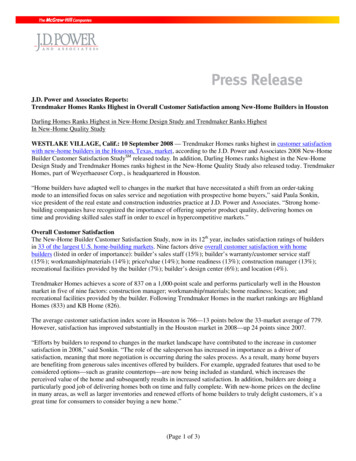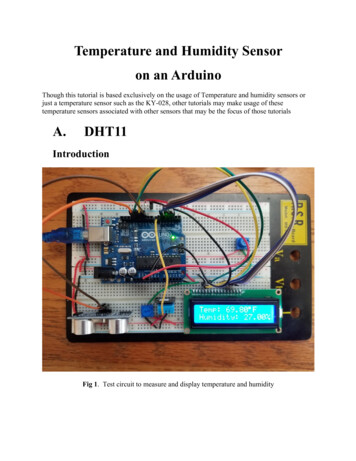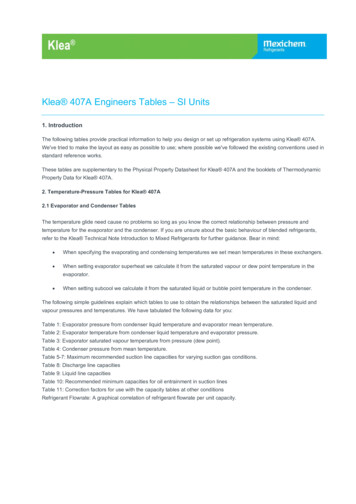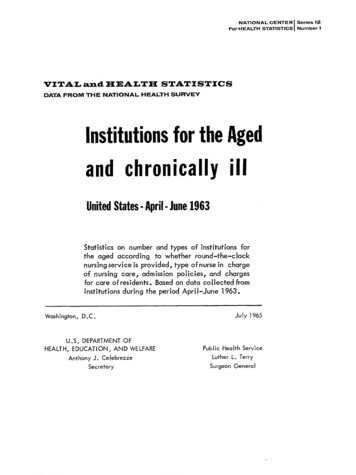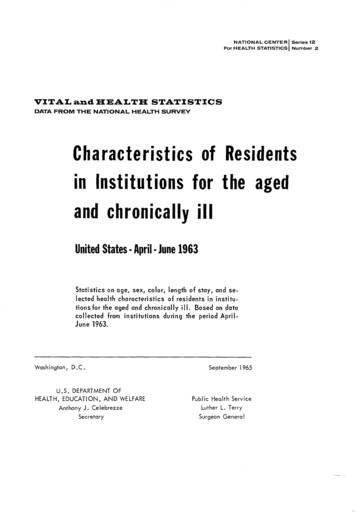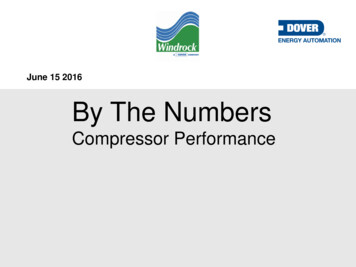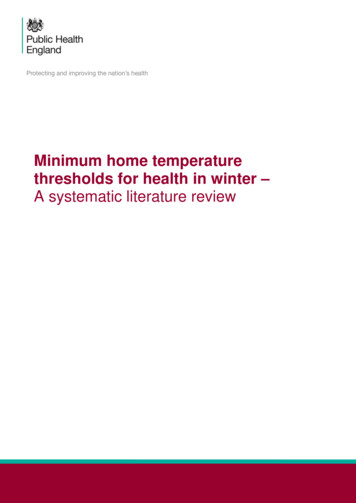
Transcription
Minimum home temperaturethresholds for health in winter –A systematic literature review
Minimum home temperature thresholds for health in winter: A systematic literature reviewAbout Public Health EnglandPublic Health England exists to protect and improve the nation's health and wellbeing, andreduce health inequalities. It does this through advocacy, partnerships, world-class science,knowledge and intelligence, and the delivery of specialist public health services. PHE is anoperationally autonomous executive agency of the Department of Health.Public Health EnglandWellington House133-155 Waterloo RoadLondon SE1 8UGTel: 020 7654 8000www.gov.uk/pheTwitter: @PHE ukFacebook: www.facebook.com/PublicHealthEnglandPrepared by: Rachel Wookey, Dr. Angie Bone, Catriona Carmichael, Anna CrossleyFor queries relating to this document, please contact: extremeevents@phe.gov.uk Crown copyright 2014You may re-use this information (excluding logos) free of charge in any format or medium,under the terms of the Open Government Licence v2.0. To view this licence, visit OGL oremail psi@nationalarchives.gsi.gov.uk. Where we have identified any third party copyrightinformation you will need to obtain permission from the copyright holders concerned. Anyenquiries regarding this publication should be sent to [insert email address].Published October 2014PHE publications gateway number: 20144232
Minimum home temperature thresholds for health in winter: A systematic literature reviewContentsExecutive sion53Conclusions62Acknowledgements633
Minimum home temperature thresholds for health in winter: A systematic literature reviewExecutive summaryBackgroundIn the UK, mortality is substantially higher during the winter months (December – March)when compared to other seasons. There are around 25,000 excess winter deaths inEngland each year. Excess winter deaths (EWDs) are the observed total number of deathsin winter compared to the average of the rest of the year.1The high prevalence of cold,damp, poorly energy efficient households in the UK is considered one of the main reasonswhy the UK continues to have higher excess deaths over the winter period when comparedwith other European countries.2,3Cold weather is not only associated with an increase in deaths but also has a significantimpact on morbidity.4 Many population groups are particularly at risk from coldtemperatures; vulnerable groups are widely distributed within the population and includeolder people, children and those with chronic illnesses, particularly cardiorespiratorydisease. It is those most vulnerable to cold, who also spend the majority of their timeindoors at home and may not always perceive cold temperatures because of physiologicalchanges that occur particularly with ageing.5 It is for these reasons that indoortemperature recommendations for homes are considered important to protect and improvehealth and wellbeing.The Cold Weather Plan for England 4 previously recommended indoor temperatures of18 C – 21 C. In 2014, PHE undertook to revisit the evidence on indoor temperaturethresholds and review whether the recommendations should be updated. This was inrecognition of: the importance of protecting health whilst reducing carbon emissions and avoidingunnecessary expenditure on fuel the guidance on which these original thresholds were based is now over 30 yearsold.AimTo review systematically the literature on the health impacts of cold indoor temperaturethresholds to provide evidence-based recommendations for minimum home temperaturethresholds to help reduce harm to health from cold home environments.Objectives1. Conduct a systematic literature review to look at the evidence on indoor temperaturethresholds and their impact on human health.4
Minimum home temperature thresholds for health in winter: A systematic literature review2. Use the findings of the literature review and consultation with key experts in the field ofcold weather and health to develop final recommendations that are applicable inpractice.MethodsA systematic literature review of peer reviewed papers, where the health impacts ofspecific indoor temperature(s) were assessed was conducted in February 2014. Asummary of key findings was then presented to a number of experts at the national ColdWeather Plan seminar 2014. The feedback and opinions gained from this event were thencombined with the findings of the literature review to develop the final recommendations.ResultsA total of 20 papers were included; they were very heterogeneous. Only two smallrandomised controlled trials, two cohort studies and one case control study were identified;the remainder were cross-sectional studies of varying sizes and quality, many of whichwere very small laboratory-based studies.The evidence from the small number of epidemiological studies identified suggests anassociation between raised blood pressure with exposure to indoor temperatures of around18 C or colder in the general adult population. Small laboratory studies support thefindings that exposure to cold temperatures increases blood pressure and risk of bloodclotting in healthy people who are sedentary and wearing minimal clothing, with one studysuggesting these effects start at 18 C ( /-0.5 C). Findings on the association betweenbody mass index and health effects of indoor temperature are conflicting.These findings are also likely to be applicable to older people. When the effects of cold inolder people were compared with those in younger people, the studies showed in generalthat the changes in outcomes such as blood pressure, clotting factors, cholesterol and incore and skin temperature were more profound, with slower recovery, in older people.Several studies also demonstrated reduced thermoregulatory control and thermalperception/discrimination with ageing.For people with chronic illnesses, there was only very limited information on the effects ofspecific cold indoor temperature thresholds. Among older adults with chronic obstructivepulmonary disease, better respiratory symptom score was associated with more hours ofindoor warmth (at least nine hours) at and above 21 C in the living room. Nights withbedroom temperatures of at least 9 h at 18 C showed a trend to association (P 0.04).However the choice of these thresholds was based on existing temperature guidance, andit is not clear if other (lower) temperature thresholds might have also demonstrated healthbenefits.For children, the literature suggests that there are small, and sometimes statisticallysignificant effects on children’s respiratory health from increased indoor temperatures due5
Minimum home temperature thresholds for health in winter: A systematic literature reviewto heating and energy efficiency interventions, but there is insufficient evidence availableon the impact of specific indoor temperature thresholds.DiscussionWhilst there is strong evidence that cold homes have a harmful effect on health, and thereare good arguments for making recommendations for minimum home temperaturethresholds in winter, the findings of this literature review demonstrate that there is verylimited robust evidence on which to base these recommendations.A population wide approach to minimum indoor temperature thresholds in winter iswarranted for a variety of reasons. The currently available evidence base, alongside expertdiscussion, suggests indoor temperatures of at least 18 C poses minimal risk to the healthof a sedentary person, wearing suitable clothing. Below 18 C, negative health effects mayoccur, such as increases in blood pressure and the risk of blood clots which can lead tostrokes and heart attacks.However, given the weak evidence to support this threshold, it would not be appropriate toframe this as a ‘strong’ recommendation. Furthermore the fact that certain groups areparticularly vulnerable to cold, and that younger healthy adults may find it easier toincrease activity levels and adjust their clothing, we consider that some nuancing of themessage is needed to allow flexibility above and below the threshold to allow individuals totailor their own actions. Stating clearly what the potential risks to health are in a simple,relevant and accessible way is important, to enable informed choice in heating behavioursand accommodate personal preferences.On the basis of the evidence and discussions with experts and implementers presented inthis review; the following recommendations on indoor temperature thresholds areproposed:Heating homes to at least 18 C (65F) in winter poses minimal risk to the health of asedentary person, wearing suitable clothing.Daytime recommendations The 18 C (65F) threshold is particularly important for people over 65yrs or with preexisting medical conditions. Having temperatures slightly above this threshold may bebeneficial for health. The 18 C (65F) threshold also applies to healthy people (1 – 64)*. If they are wearingappropriate clothing and are active, they may wish to heat their homes to slightly less than18 C (65F)Overnight recommendations Maintaining the 18 C (65F) threshold overnight may be beneficial to protect the health ofthose over 65yrs or with pre-existing medical conditions. They should continue to usesufficient bedding, clothing and thermal blankets or heating aids as appropriate.6
Minimum home temperature thresholds for health in winter: A systematic literature review Overnight, the 18 C (65F) threshold may be less important for healthy people (1 – 64)* ifthey have sufficient bedding, clothing and use thermal blankets or heating aids asappropriate.*There is an existing recommendation to reduce Sudden Infant Death Syndrome (SIDS). Advice isthat rooms in which infants sleep should be heated to between 16 – 20 C (61 – eThese updated recommendations should be widely disseminated to partners and otheragencies working with people in high risk groups, and incorporated into future editions ofthe Cold Weather Plan for England and Keep Warm Keep Well documents.7
Minimum home temperature thresholds for health in winter: A systematic literature reviewIntroductionMany population groups are particularly at risk from cold temperatures; the risk is widelydistributed within the population and includes older people, children and those with chronicillnesses, particularly cardiorespiratory disease. It is those most vulnerable to cold, whoalso spend the majority of their time indoors at home. Older people may not alwaysperceive cold temperatures because of physiological changes that occur with ageing5 andare therefore less likely to respond appropriately in dangerously cold environments. It is forthese reasons that indoor temperature recommendations for homes are consideredimportant to protect and improve health and wellbeing.Excess Winter Mortality and MorbidityMortality has been shown to be substantially higher during the winter months (December –March) compared to other seasons.1 There are around 25,000 excess winter deaths inEngland each year. Excess winter deaths (EWDs) are the observed total number of deathsin winter compared to the average of the rest of the year. There has been a decreasingtrend in EWDs from around 60,000 in 1950s until 2005-6, after which there has been aslight rise. Although the evidence is insufficient to be certain of the underlying cause of thisreduction, it is likely to relate to a broad range of socio-economic and other improvements,including improvements in health care, immunisation, diet and housing.Around 80% of EWDs are in those aged 75 or more.1 Most deaths are due to respiratorydisease, circulatory disease, and dementia. Underlying causes of excess winter deaths arecomplex and inter-related, but the main causes are cold temperatures and circulatingrespiratory viruses, predominantly influenza. Following a cold snap, cold related deaths willcontinue to occur for up to four weeks; evidence suggests that many of these deaths arenot those that would have occurred in the near future anyway.6 EWDs continue to behigher in the UK compared to other European countries.2,3 For these reasons, many of theEWDs observed in the UK are understood to be preventable and therefore amenable tointervention.Cold weather is not only associated with an increase in deaths but also impactssignificantly on morbidity by increasing the risk of heart attacks, strokes, respiratoryillnesses, flu and other diseases.3 The majority of breaches of the Emergency Departmentless than 4 hour waiting standard occur between November and March, and emergencyadmissions for respiratory disease show a particularly marked seasonal variation.7 Acutebronchitis in older people ( 65yrs) at the end of December and in early January providethe peak surge of hospital respiratory admissions and are responsible for the annualrespiratory illness burden on health care services.8 In the UK, GP consultations forrespiratory illness in older people increase by as much as 19% for every degree theoutdoor temperature drops below 5 C.9 Factors which increase the risk of admission to8
Minimum home temperature thresholds for health in winter: A systematic literature reviewhospital in older people include limited contact with family or friends and social isolation.Those with Chronic Obstructive Pulmonary Disease (COPD) are four times more likely tobe admitted for a respiratory complication in winter and having an additional chronicdisease significantly increases this risk.10,11Cold homes and fuel povertyCold homes are an important cause of excess winter mortality and morbidity.12 One studyshowed that residents of the 25% coldest homes have around a 20% greater risk of dyingduring the winter months than those in the warmest homes.13Fuel poverty in England is measured by the Low Income High Costs definition,14 whichconsiders a household to be in fuel poverty if: they have required fuel costs that are above average (the national median level)were they to spend that amount they would be left with a residual income below theofficial poverty lineThe proportion of EWDs attributable to cold homes and fuel poverty is debated, with someconflation of the separate, but overlapping issues of excess winter deaths, cold homes andfuel poverty. Estimates suggest that about 30% of EWDs are due to cold homes 15 andaround 10% due to fuel poverty,14 although this latter estimate has been contested.Currently about 2.5 million people live in fuel poverty 16 with 4.9 million homes non-decentbecause of excessive cold, damp, poor air quality or inadequate facilities.17 Local publichealth teams report that paradoxically EWDs tend to be higher in more affluent areas,thought likely to represent owner occupiers living in older, colder homes.18There is reasonably strong evidence for positive health effects of interventions related toheating and energy efficiency upgrades in housing; there are potential benefits for reducingsymptoms of respiratory and other chronic diseases, improvements in mental health,reduced contact with health services, and absence from school or work.19,20 The balance ofcosts and benefits varies widely between studies, and the best justification for supportinghousing energy efficiency upgrades is if the health, social, environmental and economicobjectives are considered together.21 The National Institute for Health and Care Excellence(NICE) will shortly be publishing guidance to address excess winter deaths and illnessesfrom cold homes.The Cold Weather PlanThe Cold Weather Plan for England (‘the plan’) was launched in 2011 as a frameworkintended to protect the population from harm to health from cold weather. It aims to alertpeople to the negative health effects of cold weather and enable them to prepare andrespond appropriately. A series of steps is recommended for the NHS, local authorities,9
Minimum home temperature thresholds for health in winter: A systematic literature reviewsocial care, and other public agencies, professionals working with people at risk,individuals and the voluntary and community sector.4The plans of 2011-13 recommend minimum indoor temperature thresholds of 21 C forliving rooms and 18 C for bedrooms.4 These recommendations were derived from anumber of policy and research papers including the World Health Organization’s (WHO)report ‘Health Impacts of Low Indoor Temperatures’.22 The same temperature range isused to inform housing standards,23 is used in fuel poverty statistics 24 and is used in theHills Fuel Poverty Review ‘Getting the Measure of Fuel Poverty’.14The WHO guidance aimed to protect health of those considered more at risk of thenegative health impacts of cold, such as the very old and very young.22,23 They concludedthat for sedentary individuals, there is minimal risk to health if temperatures are maintainedat a range of between 18 C - 24 C. The guidance recommended a minimum airtemperature of 20 C for ‘the sick, the handicapped, the very old and the very young’. Thisoften cited report 22 is now over 30 years old with much of the evidence used even older.In recognition of the importance of protecting health whilst reducing carbon emissions andavoiding unnecessary expenditure on fuel, PHE undertook to revisit the evidence on indoortemperature thresholds and review whether the recommendations should be updated. Theneed to review this evidence was further highlighted when the Cold Weather Plan forEngland 2013 4 was published during a period of intense public concern regarding energyprices in October 2013. PHE received a number of enquiries seeking clarification on theevidence base for indoor temperature threshold recommendations contained in the plan,and to which population groups they applied.Setting recommendationsOne of the key issues this review seeks to address is whether the advice given in the planshould be targeted at the general population or whether messaging should be aimed atspecific high risk groups. This population versus risk reduction approach can be illustratedby the ‘Prevention Paradox’, whereby greater benefits may be obtained through a wholepopulation approach than a high-risk only approach (Figure 1).10
Minimum home temperature thresholds for health in winter: A systematic literature reviewFigure 1: High risk or population approaches to health interventions% of populationThe population approach: shifts entiredistribution by encouraging everyoneto changeRisk reduction approach:shifts high risk people intolower risk groupLowNormalHighLevel of risk(Adapted by R Wookey from: Rose, G., 1985: Sick individuals and sick populations. In: Int J Epidemiol. 12:32-28.)An additional advantage to this wider approach is that it may assist in addressing the issueof people not identifying with themselves as vulnerable.Understanding the distribution and determinants of vulnerability to cold is important andneeds to be considered in the context of this review. Vulnerability to cold is widelydistributed throughout the population and is recognised to be a fluid concept; a ‘state’which people, through various stages in their life, may move into and move out of. It is alsoa multifactorial concept and not necessarily confined to individual characteristics such ashealth status or age alone.25 Instead, many factors come into play including low income,social networks and the interaction with these factors on systems of provision andgovernance.25AimTo review systematically the literature on the health impacts of cold indoor temperaturethresholds to provide evidence-based recommendations for minimum home temperaturethresholds to help reduce harm to health from cold home environments.11
Minimum home temperature thresholds for health in winter: A systematic literature reviewObjectives1. Conduct a systematic literature review to look at the evidence on indoor temperaturethresholds and their impact on human health.2. Use the findings of the literature review and consultation with key experts in the field ofcold weather and health to develop final recommendations that are applicable inpractice.ScopeThis review focuses on minimum indoor temperatures of the domestic environment in theperiod of operation of cold weather alerts in the Cold Weather Plan (November to March).The reviewers acknowledge the important impact that overheating has on occupant health,but this review does not seek to establish maximum indoor temperature thresholds forhealth.MethodsA systematic literature review was conducted to identify peer reviewed papers on thehealth impacts of cold indoor temperatures, where the health impacts of specific indoortemperature(s) were assessed. The preliminary results were then presented to a number ofexperts at the National Cold Weather Plan seminar 2014. The feedback and opinions fromthis event were then considered when reaching the conclusions of this review andfinalising the recommendations.The literature searchThe literature search was carried out in February 2014 and aimed to identify peerreviewed, primary research papers. The following five medical databases were searched:PubMed, OVID, Medline, EMBASE (Excerpta Medical Database Elsevier), and CINAHL(Cumulative Index to Nursing and Allied Health Literature). Table 1 details the searchterms and Boolean operators used.12
Minimum home temperature thresholds for health in winter: A systematic literature reviewTable 1: Search termsPrimary Search TermCold ANDIndoor ANDHealth ANDSecondary Search TermOR weather OR ambient OR winter OR seasonalOR low OR cold threshold OR temperature ORenvironment OR thermal comfortOR room OR home OR dwelling OR lounge ORdayroom OR day-room OR bedroom OR houseOR inside OR housingOr myocardial infarction OR coronary OR heartattack OR stroke OR angina OR blood pressureOR hypothermia OR COPD OR chronicobstructive pulmonary disease OR influenza ORflu OR asthma OR bronchitis OR respiratorydisease OR dementia OR fall OR accident ORinjury OR mental health OR depression ORmorbidity OR mortality OR excess winter deathsOR health OR wellbeing OR vulnerability ORelderly OR infirm OR older peopleInclusion and exclusion criteria (table 2) were discussed with experts in the field toincrease likelihood of capturing all relevant published work. Figure 2 documents theprocess of the literature search to identify suitable articles for review.Table 2 Inclusion and exclusion criteriaInclusion criteria- Primary research- Human- All ages- All years- References to specific temperatures orthresholds- English- All physical and mental healtheffectsExclusion Criteria- Secondary research- Non-English papers- Air quality- Social effects- Heat or over heating- Outdoor temperatures- Workplace/industrial environment- Housing standards- No reference to health effects- No reference to specific temperature/threshold- Perception of temperature/thermal comfort- Effects of energy efficiency measures/interventions(insulation etc.)13
Minimum home temperature thresholds for health in winter: A systematic literature reviewFigure 2 – Search processDatabases:OVID } EMBASE} CINAHL Plus n 8,985PubMed/Medline n 44,853TOTAL n 57,024Title screeningn 3,213Excludedn 53,811Abstract screeningn 265Excludedn 2,948Detailed reviewn 84Excludedn 63Externalsource/citationchainingn 2Includedn 2014
Minimum home temperature thresholds for health in winter: A systematic literature reviewA total of 57,024 titles were identified from which 3,213 abstracts were checked forsuitability and a total of 265 were selected, after application of inclusion and exclusioncriteria. A total of 63 papers were then discarded after reading in full. A further two paperswere identified for inclusion by citation chaining. Policy documents and reports 4,12,14 werealso checked for citations to ensure peer review articles relevant to the question werecaptured. A total of 20 papers were included.Weighting the evidenceThe majority of studies meeting the inclusion criteria were observational/cross sectionalstudies and were graded using the National Institute for Health (NIH) grading system,which includes checklists for this type of study design as well as randomised studies, casecontrol and cohort studies.Other frameworks were considered, such as the Scottish Intercollegiate GuidelinesNetwork (SIGN) which although appropriate for the consideration of evidence which willlead to guidance and recommendations for heath, do not include tools for evaluatingevidence from cross-sectional studies. In addition, the Grading of Recommendations,Assessment, Development and Evaluation (GRADE) system was considered, however,one of the limitations of using the GRADE system for this particular review is that theframework was primarily designed to address questions about alternative managementstrategies, interventions, or policies in terms of individual-level clinical interventions. TheEuropean Centre for Disease Prevention and Control suggest that there are otherchallenges in using GRADE for use in public health with some categories of studies whichcannot be assessed by GRADE.26The NIH checklists enabled the reviewers objectively to account for the methodologicalquality of individual studies alongside the weight of evidence and consistency of findings tosupport evidence-based recommendations. Two reviewers independently classified studydesign, completed a methodology checklist, made a quality rating of each study andassigned a grade. The grades were then compared and if there was a disparity thereviewers discussed the paper and assigned an agreed grade. The results were thendiscussed with a two further members of the reviewing team for finalised grading.A total of 20 papers were included in the review. These were discussed with experts in thefield and cross checked with recently published evidence reviews to ensure that no otherwork (published or emerging) was overlooked.15
Minimum home temperature thresholds for health in winter: A systematic literature reviewResultsThe results are presented below and organised by population group (general, older people, thosewith chronic illness and young people). A detailed critique of each paper can be found in eachaccompanying table.General adult populationFor the purposes of this review, the general adult population is defined as adults betweenthe ages of 16 and 64 years.A total of 12 papers examined the impacts of indoor temperature thresholds on the generalpopulation. Health outcomes included blood pressure, body mass index, haematologicaland biochemical markers, and changes to core and skin temperature. The 12 studies are:one small randomised controlled trial of adults without relevant pre-existing disease;27 fourlarge population-based studies;28,29,30 (where levels of pre-existing disease are not alwaysclear); and seven very small, laboratory-based studies of healthy adults.32,33,34,35,36,37 Theselaboratory-based studies used small sample sizes and volunteers, often with levels ofactivity and clothing that are unlikely to be experienced in day to day life. Althoughconsistent in their findings, they lack external validity (ie the extent to which the results of astudy can be generalised to other situations and to other groups of people) and thereforeprovide only weak evidence which is supportive rather than conclusive.Table 3 shows a detailed summary of all papers examining health effects on the general,adult population.16
Minimum home temperature thresholds for health in winter: A systematic literature reviewTable 3 – Summary of studies on the general adult populationRef.NoStudy/author/yearAim of study& designNIHGradePopulation &settingExposureOutcomesmeasuredResultsStrengths and Limitations27Saeki, K.,Obayashi,K,Iwamoto, J.,Tanaka, Y.,Tanaka, N.,Takata, S.,Kubo, H.,Okamoto, N.Tomioka, K.,Nezu, S.,Kurumatani,N., 2013.Influence ofroomheating onambulatorypressure inwinter: arandomisedcontrolledstudy.To determinewhetherintensive roomheating in winterdecreasesambulatory BPas comparedwith weak roomheating resultingwhen sufficientclothing andbedclothes areavailable.GOOD146 adults withno chroniccardiovascularillness,diabetes orkidney diseaseaged 18-60yrs. from theNaraprefecture inJapan wherewintertemperaturesaverage about3 to 5 CIntensiveheating group:11h over nightat 22 C. Weakheating group :11h over nightat 12 CPrimaryoutcomes:Evening BP(2h prior togoing to bed),night-time BP(mean whilstin bed),morning BP(2h aftergetting up)and morningBP surgeMorning and evening BPmeasurements were found to belower in those in an intensivelyheated room (22 C) compared tothose in a room heated to only12 C. Morning systolic was lowerby 5.8mmHg (95% CI 2.49.3mmHg p 0.01) and diastolicby 5.1mmHg (95% CI 2.3 7.9mmHg p 0.01). Morning BPsurge was supressed to twothirds of that observed in thecolder room (sleep trough BPsurge 14.3 (SD 8.7) vs 21.9 (SD10.9) mmHg p 0.01); prewaking BP surge, 9.7 (SD 8.4) vs14.9 mmHg (SD 9.6) p 0.01).Confounders controlled forinclude age, gender, BMI andsmoking, but not alcoholconsumption or othermedication use such as thosefor thyroid.Parallel group,assessorblinded, simplerandomisedcontrolled studywith 1:1allocation.Secondaryoutcomes:Mean p qualityNo statistically significantdifference in night-time BP andauthors suggest this is due to theincreased use of bedclothes andblankets.Authors suggest that intensiveheating to 22 C may reduceclinical stroke by 25.5% andhaemorrhagic stroke by 12.4%and all-cause mortality by 12.4%in the elderly, although thesample were adults aged 18-60.Participants were blinded toallocation until testing began.They were randomly assignedto their group by an allocatorusing random sequencing. Theparticipant supervisor and dataanalyst were blinded toexposure. BP, body and roomtemperature were measuredusing automated devices andmeasurements were masked.This blinding of participants,supervisor and analyst isconsidered a major strength ofthis study.Primary outcomes wer
findings that exposure to cold temperatures increases blood pressure and risk of blood clotting in healthy people who are sedentary and wearing minimal clothing, with one
